ACUFO-1945-00-00-JAPAN-2
As my catalog shows, in 1945, the crews of American B-29 bombers of the XXIst Bomber Command who carried out day and night raids on Japan often reported seeing “balls of fire” whose nature sometimes remains very uncertain.
The uncertain nature of these “balls of fire” was the subject of an article on April 26, 1945 in the secret bulletin of the American Air Intelligence of the XXIst Bomber Command, Air Intelligence Report.
The article on these “balls of fire” was preceded by an article on the piloted rocket-propelled flying bomb “Baka”, aka “Viper” that the Japanese used for “Kamikaze” missions. The article on the “balls of fire” was dealing with the question of whether “balls of fire” could be explained by these craft, but the conclusion remained undecided.
The article included 12 cases of “balls of fire” reports, without date or location reference, but coming from reports of the XXIst Bomber Command B-29 bombers air raid missions over Japan in 1945. One of the sample reports said:
“Red ball of fire, estimated 12 inches diameter, seen after turn from target. B-29 heading 120 degrees, speed 220 K, altitude 7,000 feet. Ball of fire seen two o'clock high, closed on tail, level, followed B-29 level approximately 30 miles. Then made steep dive, hit round, five distinct bright white explosions seen... first seen about 25 to 30 miles beyond coast line over the ocean.”
| Date: | 1945 |
|---|---|
| Time: | ? |
| Duration: | 6 - 7 minutes. |
| First known report date: | April 26, 1945 |
| Reporting delay: | Hours, several months. |
| Country: | Japan |
|---|---|
| State/Department: | |
| City or place: |
| Number of alleged witnesses: | ? |
|---|---|
| Number of known witnesses: | ? |
| Number of named witnesses: | 0 |
| Reporting channel: | Military Intelligence summary report. |
|---|---|
| Visibility conditions: | ? |
| UFO observed: | Yes. |
| UFO arrival observed: | ? |
| UFO departure observed: | Yes. |
| UFO action: | Descended, followed plane on 30 miles, exploded. |
| Witnesses action: | |
| Photographs: | No. |
| Sketch(s) by witness(es): | No. |
| Sketch(es) approved by witness(es): | No. |
| Witness(es) feelings: | ? |
| Witnesses interpretation: | ? |
| Sensors: |
[X] Visual: ?
[ ] Airborne radar: [ ] Directional ground radar: [ ] Height finder ground radar: [ ] Photo: [ ] Film/video: [ ] EM Effects: [ ] Failures: [ ] Damages: |
|---|---|
| Hynek: | ? |
| Armed / unarmed: | Armed, 12 Browning M2 12,7 mm machine guns. |
| Reliability 1-3: | 2 |
| Strangeness 1-3: | 2 |
| ACUFO: | Unidentified. |
[Ref. aaf2:] U.S. ARMY AIR FORCES:
This report was in the secret bulletin Air Intelligence Report of the XXIst Bomber Command, U.S. Army Air Forces, for April 26, 1945.
After a presentation of the “Baka” aka “Viper” piloted rocket suicide bomb (see my Discussion section), a chapter title “Are these fireballs?” expanded on whether this craft was the “balls of fire” reported by B-29 pilots in the Pacific in 1944 - 1945.
12 examples of reports of “balls of fire” are cited; unfortunately, generally without date or location or information on the involved unit.
The introduction read:
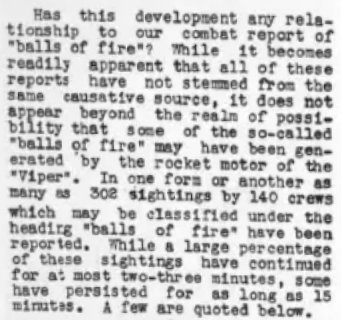
|
Has this development [the “Baka” aka “Viper”] any relationship to our combat reports of “balls of fire”? While it becomes readily apparent that all of these reports have not stemmed from the same causative source, it does not appear beyond the realm of possibility that some of the so-called “balls of fire” may have been generated by the rocket engine of the “Viper”. In one form or another as many as 302 sightings by 140 crews which may be classified under the heading of “balls of fire” have been reported. While a large percentage of these sightings have continued for at most two-three minutes, some have persisted for as long as 15 minutes. A few are quoted below.
Quoted below were indeed 12 reports summaries, including:
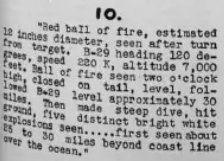
|
“Red ball of fire, estimated 12 inches diameter, seen after turn from target. B-29 heading 120 degrees, speed 220 K, altitude 7,000 feet. Ball of fire seen two o'clock high, closed on tail, level, followed B-29 level approximately 30 miles. Then made steep dive, hit round, five distinct bright white explosions seen... first seen about 25 to 30 miles beyond coast line over the ocean.”
The reports were followed by these comments:
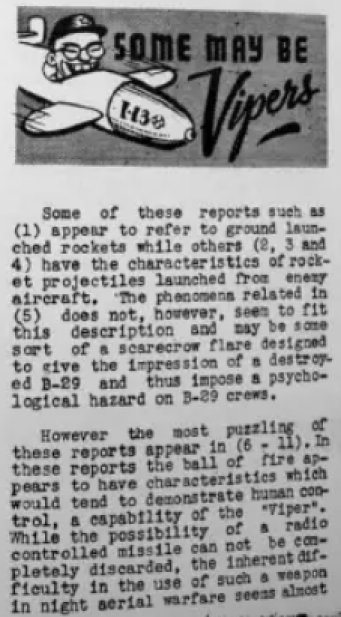
|
Some of these reports such as (1) appear to refer to ground launched rockets while others (2, 3 and 4) have the characteristics of rocket projectiles launched from enemy aircraft. The phenomena related in (5) does not, however, seem to fit this description and may be some sort of a scarecrow flare designed to give the impression of a destroyed B-29 and thus impose a psychological hazard on B-29 crews.
However the most puzzling of these reports appear in (6 - 11). In these reports the ball of fire appears to have characteristics which would tend to demonstrate human control, a capacity of the “Viper”. While the possibility of a radio controlled missile ca not be completely discarded, the inherent difficulty in the use of such a weapon in night aerial warfare seems almost
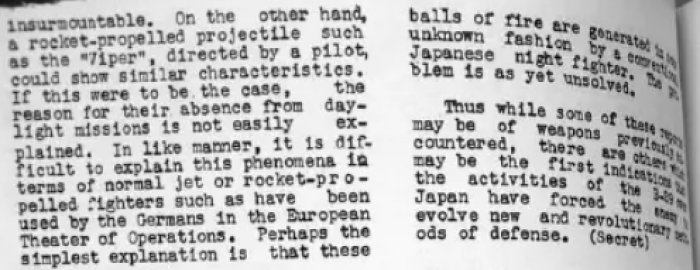
|
insurmountable. On the other hand, a rocket-propelled projectile such as the “Viper”, directed by a pilot, could show similar characteristics.
If this were to be the case, the reason for their absence from daytime missions is not easily explained. In like manner, it is difficult to explain this phenomena in terms of normal jet or rocket-propelled fighters such as have been used by the Germans in the European Theater of Operations. Perhaps the simplest explanation is that these balls of fire are generated in an unknown fashion by a conventional Japanese night fighter. The problem is as yet unsolved.
Thus while some of these reports may be of weapons previously encountered, there are others which may be the first indications that the activities of the B-29 have forced the enemy to evolve new and revolutionary methods of defense. (Secret)
The Boeing B-29 “Superfortress” was the heaviest bomber of the U.S. Army Air Forces, used in operations from May 8, 1944 and on. Its maximum speed was 574 km/h.
Its defensive armament was 12 Browning M2 12.7 mm machine guns.
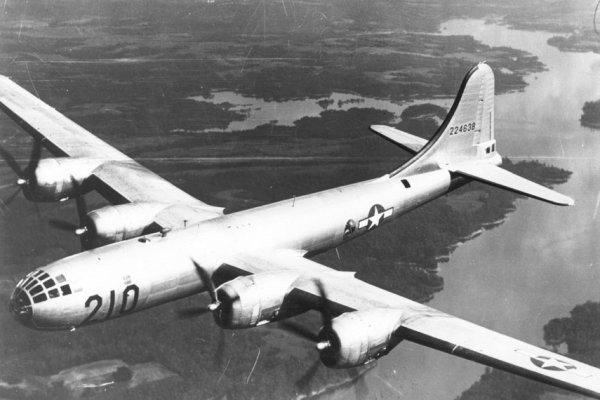
|

|
The B-29's were generally flying at 240 miles per hour, particularly when they left the coast after bomb away. This means that the sighting duration, on the 30 miles, was about 6 - 7 minutes.
The report is unfortunately without date, without hour, and with much details.
The Intelligence report did not “buy” the “Baka” explanation; this is understandable as the pacing is very long, and no attack was done. In other words, if it were a “Baka”, its pilot just wasted an aircraft and died for nothing when he could have actually fires at the B-29.
Also, the “Baka” could not have paced a B-29 for so long because at the B-29 speed, the Baka would have stalled soon.
“Baka” (photo below), or “Viper”, was the allied code name for the Yokosuka MXY-7 “Ohka”, a rocket-powered human-piloted kamikaze attack aircraft used by the Japanese air forces against Allied ships towards the end of the Pacific War during World War II. It was extremely fast, but with a very short range, so that it had to be carried into action as a parasite aircraft by a much larger bomber.
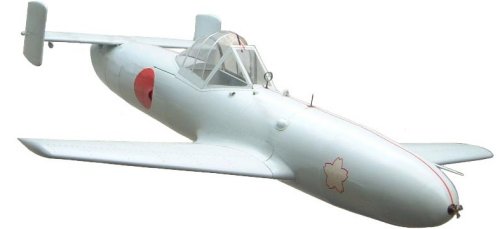
|
Unidentified.
* = Source is available to me.
? = Source I am told about but could not get so far. Help needed.
| Main author: | Patrick Gross |
|---|---|
| Contributors: | None |
| Reviewers: | None |
| Editor: | Patrick Gross |
| Version: | Create/changed by: | Date: | Description: |
|---|---|---|---|
| 0.1 | Patrick Gross | July 16, 2024 | Creation, [aaf2]. |
| 1.0 | Patrick Gross | July 16, 2024 | First published. |